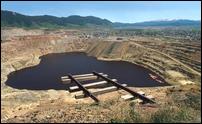Estimated read time: 2-3 minutes
This archived news story is available only for your personal, non-commercial use. Information in the story may be outdated or superseded by additional information. Reading or replaying the story in its archived form does not constitute a republication of the story.
SALT LAKE CITY — Two Utah Superfund sites are among 22 areas across the country the U.S. Environmental Protection Agency announced Thursday are clear of harmful contamination and suitable for reuse.
Those sites are Eureka Mills in Juab County's Eureka and the Davenport and Flagstaff Smelter site in Sandy.
The deletion or partial deletion of those 22 Superfund sites from the National Priorities List is the largest number of deletions since 2005, according to the agency.
In May of 2017, the EPA launched the Superfund Task Force to review the existing policies and procedures related to deleting sites from the list, issuing several recommendations.
By increasing the annual number of site returned to communities, the EPA frees up those previously contaminated lands for potential development.
Some of those sites are developed into parks, wildlife habitats or shopping centers.
The Midvale Slag Superfund site, after 22 years on the list, is now home to Bingham Junction.
According to the EPA, the 450-acre Eureka Mills site — part of the historic Tintic Mining District — was contaminated with heavy metals after legacy mining in the area.
State officials first detected the contamination in 2000 and cleanup involved 700 residential and commercial properties. The EPA carried out soil removals after it found high concentrations of lead and arsenic, with elevated levels of lead in the blood of some children.
EPA Hits 13-Year High in Deleting Superfund Sites, deleting all or part of 22 sites from Superfund’s National Priorities List (NPL), the largest number of deletions in one year since FY 2005 and a significant increase over the past few years. Read more --> https://t.co/m6vRoND7xtpic.twitter.com/fUOwiWihua
— U.S. EPA (@EPA) October 10, 2018
Work included grading and capping of mine sites with 18 inches of new soil and other actions until it was deemed the actions were sufficiently protective of human health.
The Davenport and Flagstaff Smelter sites, at the mouth of Little Cottonwood Canyon, involved smelters constructed in 1870 to process lead and silver ore from mines in the Alta area.
Those historical operations left soils contaminated with heavy metals.
Operations ceased in 1879, but continuing commercial and residential development increased the likelihood of public health risks.
Related:
Over the years, the EPA supervised the removal and or treatment of thousands of tons of contaminated soil.
According to the Utah Department of Environmental Quality, there are 20 Superfund sites that remain in the state. Most are the result of historic mining operations, industrial activity, landfills or military facilities where hazardous waste was handled.











